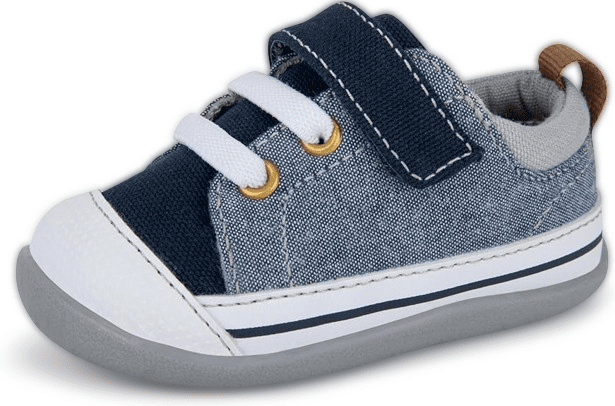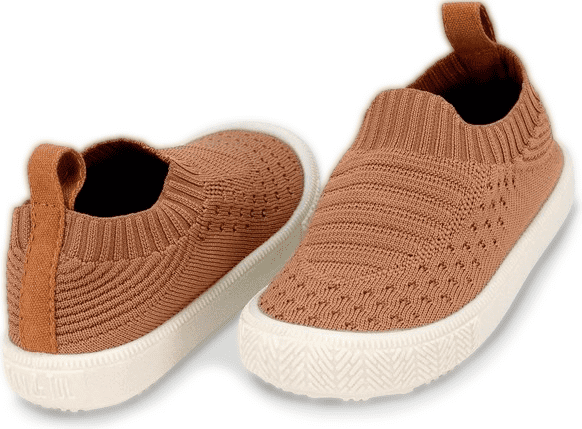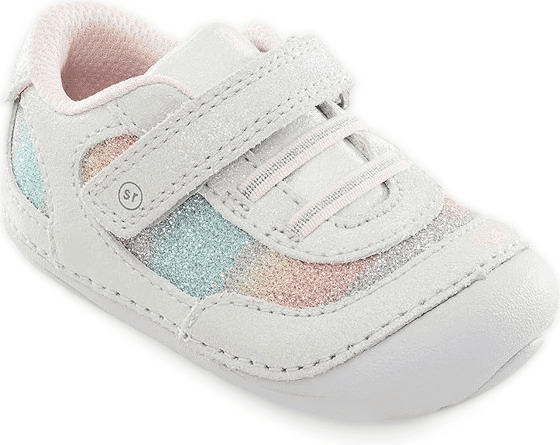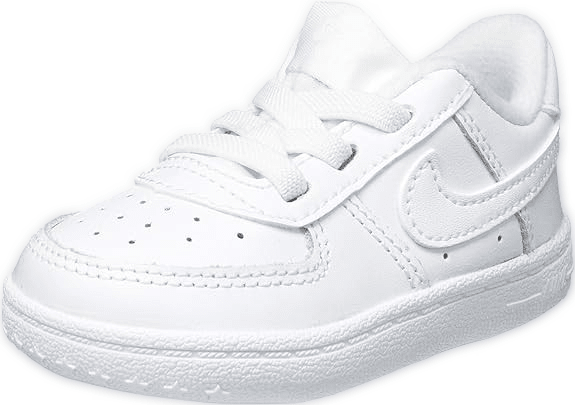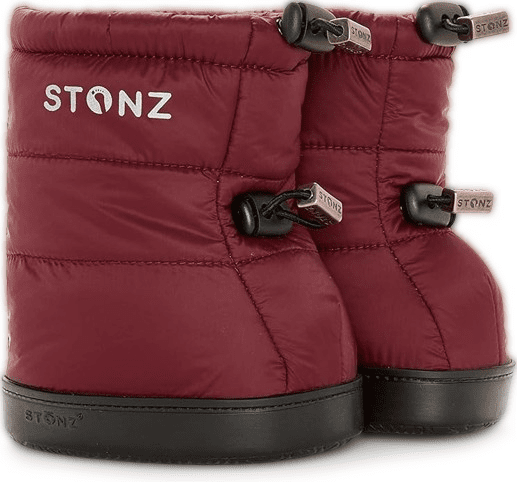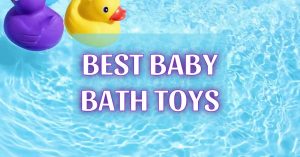The most important first steps your baby will take are just ahead. So, make sure their feet are ready in shoes made for baby’s first walking adventures! The right shoes provide support, flexibility and traction to give toddlers confidence.
In this review, we’ll cut through the clutter of baby shoe options. And we reveal the best overall picks to protect growing feet while encouraging those wobbly milestone moves. Our methodology considers key criteria like comfort, fit, durability and style to deliver standout shoes for new walkers.
- Best Baby Shoes Overall: Robeez Unisex First Kicks Slip Resistant Shoes & Sneakers for Infant and Toddler
- Best Budget Baby Shoes: JAN & JUL Machine Washable Knit Shoes
- Best comfortable Baby Shoes: Stevie II First Walker Shoe for Infants
- Most Stylish Baby Shoes: Stride Rite Soft Motion Baby and Toddler
- Best for Quality: Nike Force 1 Crib Toddler
- Best Winter Baby Shoes: Stonz Cute Winter Toddler Puffer Boots for Babies
Stevie II First Walker Shoe for Infants
The Stevie II helps little feet take big steps in total comfort. Soft fabric uppers wrap feet in breathable adjustments. The handy hook-and-loop strap combines with faux laces for a custom closure. Inside, a leather sock liner keeps tiny toes dry and relaxed. Down below, a flexible rubber sole grips surfaces while allowing natural motion.
Key Features:
Adjustable Fit
The hook-and-loop strap and faux laces ensure a secure yet customizable fit for growing feet. The straps fasten across the midfoot while the laces tie for style. This adjustable system accommodates swelling and growth spurts in infant feet.
Rubber Toe Cap
The reinforced toe box protects those inevitable stubs and stumbles of new walkers. The rubber cap shields little piggies without limiting mobility. Its durable materials withstand abrasions while flexible construction maintains comfort.
Roomy Toe Box
With space for ten tiny toes to naturally splay, this toe box optimizes development. Allowing intrinsic muscle growth prevents future foot issues tied to restrictive shoes in childhood.
Size Range:
- Available in infant shoe sizes 2 to 13
What We Love:
- Adorable color selection
- Light 1.8-ounce weight
- APMA seal of acceptance
- Durable fabric and rubber construction
Things to Consider:
- On the pricey side, $40+ per pair
- Toe cap prone to scuffing
- Runs slightly large
With the ideal blend of adjustability, protection and foot-friendly features, the Stevie II makes those momentous first steps smoother.
JAN & JUL Machine Washable Knit Shoes
These knit sneakers from JAN & JUL offer playground-to-trail versatility for active kids. The polyester fabric uppers breathe easily while elastic ankles slip on in a cinch. Down below, grippy rubber soles take on adventures of all kinds thanks to a protective toe cap.
Key Features:
Breathable Knit Fabric
The knit polyester construction keeps feet cool while allowing ventilation. Tiny toes stay dry and relaxed for all-day play in these comfy kicks.
Flexible Rubber Soles
While the tread provides traction, these soles move naturally with kids’ strides. The lightweight design also prevents leg fatigue for longer wear.
Elastic Ankle Opening
Slipping these shoes on and off grows independence in young kids. The elastic ankle stretches generously over swelling, growth spurts and chubby baby feet.
Size Range: Available in toddler sizes 4 to 7 and little kid sizes 8 to 13
What We Love
- Machine washable convenience
- Adorable color selection
- Protective extra toe cap
- Budget-friendly under $35
Things to Consider
- Size up for the best fit
- Runs large compared to standard shoes
- Soles are cream, not white
With construction designed for safety and adventure, the JAN & JUL knit sneakers handle childhood fun with ease. Let those little feet run free in breathable style!
Stride Rite Soft Motion Baby and Toddler
These playful sneakers from Stride Rite strut stylish shimmer uppers complemented by faux laces. Elastic construction slips tiny feet into plush orthite footbeds then carries them through the day. These softly supportive shoes handle childhood adventures in cushy style!
Key Features:
Ortholite Footbeds
Underfoot memory foam conforms to growing feet for customized comfort. The foam retains its plush feel over multiple machine washes while wicking away moisture.
Traction Rubber Soles
While light enough for all-day wear under 3 ounces, these durable soles stick reliably to slippery playground surfaces. Deep lugs flex naturally without skimping durability.
Adjustable Closure
Elastic laces stretch then lock feet securely into place. For greater customization, a hook-and-loop ankle strap adapts the fit as tiny feet swell and grow.
Size Range:
- Available in infant sizes 1-9 and toddler 4-13
What We Love
- Super cute metallic shimmer upper
- APMA approved for healthy development
- Rubber sole provides flexibility
- Generous fit for wide feet
Things to Consider
- Runs slightly narrow
- Lighter color shows dirt easier
- Higher $40+ price tag
Blending style and support for growing kids, these Soft Motion sneakers handle childhood play with plush ease. Let those little feet shine on!
Robeez Unisex First Kicks Slip Resistant Shoes & Sneakers for Infant and Toddler
Robeez First Kicks help little feet take big steps in total comfort. Soft leather shapes to tiny toes as flexible soles move naturally underneath. With an elastic ankle band, these kicks slip on easily and stay snugly in place. From those first tentative steps to confident strides, these supportive shoes stick by growing babies’ stride for stride.
Key Features:
Split Rubber Soles
The segmented sole flexes to allow natural foot motion critical for development. Grippiness prevents slips while shock absorption softens strides on hard floors.
Leather Uppers
Buttery soft leather enfolds little feet in breathable comfort. The quality material conforms gently without chafing or abrasion across delicate skin.
Adjustable Ankle
The stretchy elastic band adapts to swelling baby feet. By expanding then contracting around the ankles, First Kicks shoes stay securely on new walkers.
Size Range:
- Available in infant sizes 0-12 months
What We Love
- Flexible sole promotes healthy foot motion
- APMA seal of acceptance
- Quality leather material
- True-to-size fit
Things to Consider
- Hand wash only
- Plain style lacks flair
- Runs narrow
Blending flexible support with comfort, Robeez First Kicks give those momentous first steps a boost of confidence. Let little feet roam free!
Nike Force 1 Crib Toddler
Let your little one strut legendary Nike style right from their first steps. The Force 1 baby shoes wrap tiny feet in soft leather, with sporty accents front to back. While hints of Air Force heritage salute greatness ahead, traction tread and cushy insoles focus firmly on the present moment.
Key Features:
Plush Insoles
Underfoot foam gently cushions falls and stumbles inevitable for new walkers. The soft padding reflects shock before it reaches tender toes still finding their balance.
Durable Leather
Full-grain leather covers feet durably while conforming comfortably across the top. It’s easy-clean finish withstands inevitable baby messes from food to mud.
Elastic Laces
These expandable laces stretch easily over chubby feet and swollen ankles. Once in place, they gently lock feet down for a secure adjustable fit while on the move.
Size Range:
- Available in infant sizes 0-4
What We Love
- Iconic Nike style starts early
- Quality leather material
- Foam insole for comfort
- True to size fit
Things to Consider
- High $50+ price tag
- Limited size range
- Runs slightly narrow
Before crossing the stage, first comes crossing the living room! With legendary heritage tailored tot-sized, the Force 1 baby kicks inspire greatness with every step.
Stonz Cute Winter Toddler Puffer Boots for Babies
When chilly weather strikes, keep little feet cozy in Stonz toddler puffer boots. A plush fleece lining enfolds feet in warmth while water resistant nylon blocks cold air. With a flexible heelless design, these snow boots move naturally with early steps and stance. Just cinch the toggles for a snug supportive fit to explore outdoors all winter long!
Key Features:
Fleece Lining
Plush fleece fabric lines the interior keeping sensitive skin comfy and dry. By wicking moisture, breathable fleece prevents overheating inside the waterproof shell.
Adjustable Toggles
Simple pull cords circle the ankle and calf for quick customization. Once cinched, these toggles lock feet securely in place and prevent boots from slipping down.
Non-Slip Soles
While remaining soft and flexible, textured rubber soles prevent slips outdoors. Deep sipping and tread patterns channel water away from slick surfaces for puddle play.
Size Range:
- Available in toddler sizes 2-7
What We Love
- Reflective exterior visibility
- Warm fleece lining
- Easy slip-on style
- Non-marking durable outsoles
Things to Consider
- Sizing runs slightly large
- Hand wash or spot clean only
- Snowsuit pants may not fit over boots
With cold weather protection wrapped in cozy comfort, Stonz boots let little adventurers roam winter wonderlands worry-free!
Children’s Shoe Size Chart
| Category | Age | US Size | EU Size |
| Infant | 0-1 years | 0-4 | 16-21 |
| Toddler | 1-3 years | 4-10 | 21-28 |
| Little Kid | 3-6 years | 10.5-13 | 29-34 |
| Big Kid | 6-12 years | 13.5-7 | 35-41 |
Developmental Milestones: When to Introduce Shoes to Your Baby
Most experts recommend introducing shoes once a baby begins pulling themselves up and taking their first steps. They mean your kids would be minimum 9-12 months of age. At this stage, shoes can provide extra protection on hard surfaces as they practice walking.
However, it’s important to still allow plenty of barefoot time to develop foot strength and mobility. Research shows babies who spent more time barefoot during early development had stronger foot muscles.
Navigating the World of Soft-Soled vs. Hard-Soled Shoes for Babies
The table below summarizes the pros and cons of soft-soled versus hard-soled shoes for different age groups:
| Age | Soft-Sole Pros | Soft-Sole Cons | Hard-Sole Pros | Hard-Sole Cons |
| 9-18 months | Allows toe splay and flexibility | Less durable for outdoors | More durable | Can restrict movement |
| 18-24 months | Good transition option | – | More stable for active toddlers | – |
| 2 years + | – | Less supportive for active kids | Very supportive | Less flexibility |
For new walkers under 18 months, soft-soled shoes are generally best to allow for natural toe splay and foot development according to orthopedic specialists.
Choosing the Right Style: Sneakers, Sandals, or Boots for Little Walkers
Sneakers are a top choice because a 2021 study in the Journal of Pediatrics found they provide flexibility and traction protection. For ventilation, sandals with a back strap can work well below 90°F according to the American Podiatric Medical Association. Boots add 1-2 inches of traction height which research links to improved stability on slippery surfaces.
Ensuring a Perfect Fit: A Guide to Measuring Baby and Toddler Shoe Sizes
The Brannock Device is considered the most accurate tool for measuring foot length and width. Place the babe’s foot on the scale and ensure plenty of space in the following areas:
- Toe room – 1/2 inch minimum
- Ball area – snug but not tight
- Heel – slight slipping ok if on growth phase
Breaking Myths: Do Babies Really Need Shoes to Learn to Walk?
A 2010 study in Clinical Pediatrics found no difference in walking achievement ages between babies exposed to frequent shoe wearing. In fact, those with more barefoot time walked on their toes more stable than frequent shoe wearers. Overall, current research suggests shoes are not required for initial walking development.
Tips for Optimal Foot Development in New Walkers
In addition to the tips mentioned, look for shoes with the following features:
- Breathable uppers (fabric instead of plastic or leather which can overheat small feet)
- Flexible leather or synthetic soles with traction patterns not heel/toe rigidity
- Wide toe boxes allowing 10 adult fingers width for five toes to splay naturally
Common Pitfalls to Avoid When Selecting Baby Walking Shoes
Avoid shoes with the following features:
- Enclosed toes or heels that don’t allow natural foot functions
- Rigid inserts, arch supports or padding that don’t flex with foot motions
- Too narrow toe boxes squeezing the forefoot
- Slim unstable heels without adequate rearfoot coverage
Factors to Consider: Weather, Terrain, and Other Environmental Influences
The chart below outlines best shoe features according to different weather conditions:
| Weather | Traction | Material | Other Features |
| Wet/muddy | Deep lug patterns | Waterproof leather/rubber | Tall coverage, quick dry lining |
| Snow/ice | Aggressive lugs, grip pads | Insulating fleece or wool | Felt or fleece lining, waterproof |
| Dry/hot | Washed rubber sole | Breathable mesh/suede | Ventilated, moisture-wicking |
| Rough terrain | Multi-directional lugs | Durable scotchguard upper | Ankle support, thick sole |
Making the Transition: When and How to Gradually Increase Shoe Usage
A gradual introduction is best to breaking in shoes according to the American Academy of Pediatrics. Start with 10-15 minutes indoors only, then increase outdoor time by 5 minutes every few days.
By 18 months, shoes may be worn 2-4 hours at indoor play. Cue tolerance – remove shoes promptly if baby seems uncomfortable or foot rubbing occurs.
Caring for Baby Shoes: Cleaning, Maintenance, and Replacement
Hand washing or spot cleaning with gentle soap and water is best for delicate baby shoe materials according to the EPPIC shoe care guide. Allow shoes to air dry completely between each wearing to remove moisture which can breed bacteria.
Inspect for wear every few weeks – the heel counters or soles should not be worn down more than 30% for safety. Replace shoes every 3-6 months as feet grow 1/2 to 1 full shoe size on average.
Expert Insights: Podiatrists’ Recommendations for Baby Foot Health
A 2021 international study published in the Journal of the American Podiatric Medical Association surveyed 100 pediatric podiatrists on their top recommendations:
- 96% advised allowing plenty of barefoot playtime for natural muscle development.
- 88% said to measure both feet and buy to the larger size to prevent deformities from ill-fitting shoes.
- 75% warned against enclosed toe areas or excessive heel counter rigidity in infant shoes.
Budget-Friendly Options: Affordable and Quality Baby Walking Shoes
The table below lists several affordable baby shoe brands meeting quality and safety standards:
| Brand | Price Point | Key Features |
| Cat & Jack (Target) | $10-25 | Breathable fabrics, flexible soles |
| Cloudbabies | $15-30 | Organic cotton, fair trade |
| Robeez | $20-40 | Soft leather, minimal seams |
| Stride Rite | $30-50 | Supportive arch, durable soles |
With a little research, many quality brands offer multi-packs or sale styles under $25.
Personalizing Style: Adorable and Functional Shoe Options for Little Ones
For function with flair, brands like Jellycats, Mini Boden and Janie & Jack offer classic silhouettes personalized with charming prints like rainbows, dinosaurs or mermaids. LalabyeBaby specializes in shoes mirroring toddler favorite characters. Unique lacing designs by Carter’s, Koolaburra or Stride Rite allow customizing fit as feet grow. Fun prints boost the wear-it factor of practical shoes for little walkers.
Parental Guide: Encouraging Natural Foot Movement During Early Walking Years
In a 2020 survey by Very well Family, 59% of parents felt uncertain how to encourage feet development through play. Provide a variety of indoor surfaces for exploring bare feet including wood, carpet, rug and tile samples.
. Designate a shoe-free play area and set aside 30 minutes after naps and meals for exploration. Rotate textured items like rice, beans or bubbles to enhance sensory development through varied foot stimulation.
Final Word:
As your baby begins pulling up and taking those momentous first steps, supportive shoes can lend stability and protection on their wobbly journey. Prioritize soft, flexible materials, allowing natural foot motion as you introduce footwear. Monitor the fit closely, allowing growing room while ensuring a snug heel and toe box.
Consider removable backs or velcro straps for ease. While shoes facilitate practice walking on varied surfaces, they still make time for barefoot play to build intrinsic foot strength.
With the proper guidance, those tiny shoes can provide just the right boost of confidence for your little one’s toddling adventures ahead! By selecting the right fit, features and materials matched to your baby’s emerging skills, their shoes can allow safe exploring while respecting developing feet.


